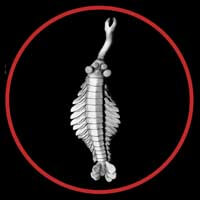
Hallucigenia sparsa is an extinct lobopodian from the Middle Cambrian period (~ 505 Mya). It is one of the most intriguing organisms to be discovered within the famous Burgess Shale fossil deposits of Canada.
Hallucigenia was originally discovered by Charles Doolittle Walcott and described as a member of the Annelida phylum (segmented worms), but later re-examination (Conway Morris, 1977) revealed that it could not be a member of this phylum. A new reconstruction suggested an unusual creature that moved around on spines with feeding tentacles reaching up from its back. It was considered so odd that it could only be imagined as part of a hallucination, so it was given its distinctive name.
Further examination revealed that the remains had previously been interpreted upside down - what were initially thought to be uniquely styled legs were in fact spines that grew up from Hallucigenia's back (Ramsköld and Hou, 1991). It was further revealed that reconstructions had also been back to front - the head was in fact the tail. This rearranging of the information helped to make sense of Hallucigenia’s anatomy although it is still regarded as bizarre.

More recent examinations of Hallucigenia fossils have identified additional features that include a series of unusual feeding appendages, a mouth with pharyngeal teeth and possible eye spots (Smith &Caron, 2015). Hallucigenia has progressively revealed itself to be a highly specialised organism.

Hallucigenia's lobopodian limbs would have been relatively weak and they terminated in small claws so it is thought that Hallucigenia may have lived by clinging to - and possibly eating - sponges, moving only slowly across the surface of the host whilst protecting itself from predation with its long dorsal spines.
Long thought to have no living descendants, Hallucigenia is now considered part of the lobopodian worm group - indirectly related to modern velvet worms - though its exact phylogeny is still being debated.
That soft bodied creatures such as Hallucigenia should have left an impression in the fossil record is remarkable in itself as it takes especially rare conditions to allow for the preservation of soft tissue - mainly by a quick burial in fine anoxic silt. These sediments are known as 'lagerstatten' and only a few have been found that contain palaeozoic life. The most famous of these is the Burgess Shale but they also include the Maotianshan Shale of China and the Emu Bay Shale of South Australia. One of the most remarkable observations about these rare and limited deposits is the great amount of life that they contain. The Burgess Shale alone has unearthed well over 65,000 specimens.
With thanks to Dr Jean-Bernard Caron for assistance with anatomical detail.





